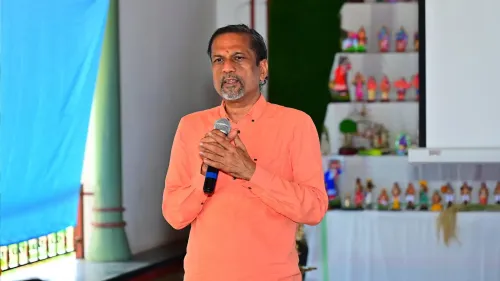Will India Welcome Two New Airports This Month?

Synopsis
Key Takeaways
- Two new airports are set to open in Delhi and Mumbai.
- The Navi Mumbai International Airport opens on October 8 and Noida International Airport on October 30.
- These developments promise to ease congestion and improve connectivity.
- India's aviation infrastructure is evolving to compete on a global scale.
- New airports will provide major capacity expansion for airlines.
New Delhi, Oct 5 (NationPress) India’s aviation industry is on the verge of a remarkable change as the nation’s two busiest cities, Delhi and Mumbai, are set to unveil new airports this month.
In line with the government's ambitious infrastructure initiative, Navi Mumbai International Airport (NMIA) is anticipated to commence operations on October 8, followed by Noida International Airport (NIA) on October 30.
These new facilities will relieve both megacities from relying on a single primary airport to accommodate the considerable volume of travelers.
The enhancements are expected to alleviate congestion, improve flight schedules, and provide more direct international routes.
This milestone aims to elevate India’s aviation framework to match global centers like New York, London, Tokyo, and Paris, where multiple airports cater to the same urban areas.
The initiation of NMIA and NIA signifies a pivotal evolution in India’s aviation sector, which has historically depended on one major airport for each city despite the surge in air travel demand.
Goa has already set a precedent by becoming India’s inaugural multi-airport city with the Mopa Airport launching in January 2023 alongside the Dabolim Airport.
For travelers, the arrival of the new airports means enhanced travel choices and improved connectivity, not just between Delhi and Mumbai, but across a broader global network.
Airlines such as IndiGo, Air India, and Akasa will benefit from the new airports, allowing for substantial capacity expansion and new route opportunities.
Experts in the industry believe that these new airports will transform Delhi-NCR and Mumbai-MMR into genuine global aviation hubs, strengthening the competition of Indian carriers against airlines from the Middle East and Europe.
The organizations behind these ambitious projects, including GMR, Flughafen Zurich, and Adani, project that passenger traffic at the new airports will soon rival or even exceed that of their existing terminals.
While the current airports in Mumbai and Goa are nearing full capacity, Delhi’s Indira Gandhi International Airport still has some potential for growth with its three terminals and four runways.
Nonetheless, the opening of Noida International Airport could hasten Delhi’s position as India’s largest air hub.
Goa's recent experience illustrates this potential. Between April 2018 and March 2019, Dabolim processed 8.46 million passengers. Following the launch of Mopa Airport in January 2023, combined traffic at both airports surged to 11 million passengers in 2023–24.
Delhi and Mumbai are expected to witness even greater increases, particularly as Delhi will effectively manage three airports once the Hindon Airbase, currently designated for regional and low-cost flights, expands its capabilities.








